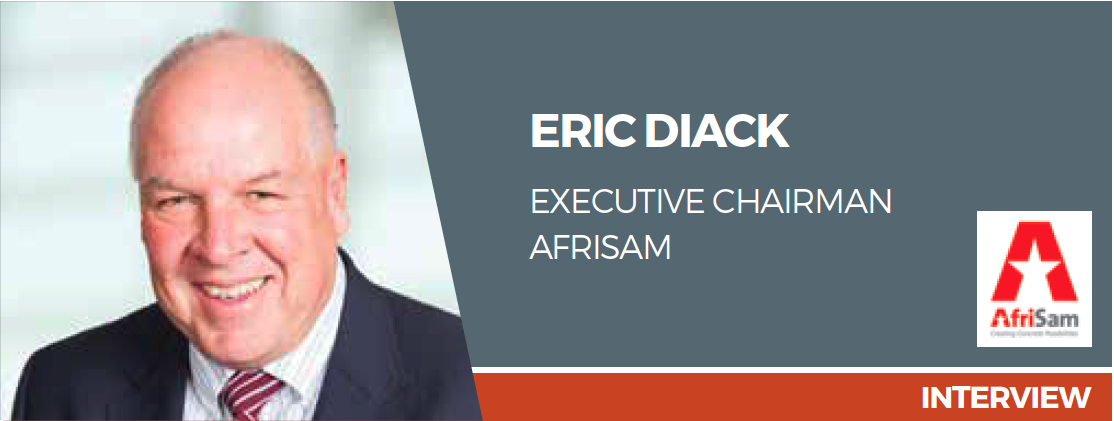
ON SUSTAINING AND GROWING IN UNUSUAL TIMES
What has the Covid-19 impact been on the cement production industry? What are the short- and longterm challenges, and how do you believe they will be overcome?
Like many other industries, Covid-19 has had a major impact on the cement production industry. During lockdown level 5 in South Africa, all of our production facilities were closed and put into care and maintenance for several weeks, which meant that no cement was produced during this period. In addition, industry segments that provide us with raw material, such as the steel and power generation industries, faced similar challenges and as a result, materials such as slag and fly ash are also currently in short supply.
As the economy started to reopen, we have seen buoyant demand for bagged cement products which has resulted in a shortage in supply. AfriSam has already implemented a number of mitigating measures to address the immediate demand for cement, which include increasing our clinker production capacity.
The muted economic growth of the country, worsened by Covid-19, remains one of the most critical long-term challenges for the cement industry. Cement demand is closely linked to the economic growth rate and, with significant surplus production capacity in the country, the continued muted demand for cement places severe pressure on profitability for cement producers. As cement producers, we have restructured our operations to ensure that we are able to produce as efficiently as possible, but in order to overcome this challenge, we will require government intervention that will stimulate infrastructure spend and future improved economic growth.

CURRENT OPPORTUNITIES
Conversely, what are the current opportunities in thesector? Where are the growth and investment areas?
Urbanisation remains a global trend and it is estimated that by the year 2050, 2/3 of the world’s population will live in urban areas. Urbanisation presents many opportunities for the construction industry as well as the cement and concrete sector. In South Africa, approximately 68%* of our citizens live in urban areas. Of these citizens, about 23%** live in informal settlements. We also have a growing population. This means that in South Africa there is a long-term demand for housing and other social development requirements such as schools, hospitals, roads and other infrastructure. In developing countries, there will inevitably be a demand for construction materials, which bodes well for our industry in the long term.
(* Statista 2020)
(** South Africa Infographics © GIZ)
Africa has a great need for infrastructure development. This provides a positive outlook for the cement, concrete and construction industry. The South African government has made infrastructure development a key focus to stimulate the economy and increase employment. Should this commitment materialise as the government intends, we will see an increased demand for cement and concrete products.
In the long term, with positive economic growth and demand for infrastructure in the SADC countries, cement producers can look forward to a positive future.
ON 4IR: THE NEXT REVOLUTION
What do you enjoy doing in your spare time, when you are not thinking about the cement production industry? How is the industry responding to the Fourth Industrial Revolution, in your view?
Generally, businesses are looking at ways to make their operations more efficient and effective. This is mainly achieved through technology. As a cement and concrete industry, and even in the construction industry, we have embraced new technologies and most certainly appreciate the value these can add to our businesses. This ranges from new equipment and automated processes in the manufacturing process to applications such as 3D concrete printers. Be that as it may, the costs of these new technologies provide some barrier to acquisition and implementation for now. I’m sure as time goes by, these will become more affordable and accessible.
However, as an industry – both in manufacturing as well as construction – we play a critical role in providing employment opportunities in the country. The construction industry provides for 8% of the total formal employment in South Africa, while manufacturing (across all sectors) accounts for 10%* of total formal employment. In developed countries, one job in the cement industry creates ten times more upstream and downstream jobs. This figure may be four to five times higher in developing countries. Therefore, it is critical that we carefully balance the need for ICT and technology adoption with providing livelihoods for our citizens.
(*Quarterly Labour Force Survey Q1:2020, Stats SA)
ON REGIONAL FACTORS
What is the status quo of the cement and concrete production industry in South Africa, and more broadly, SADC?
About a decade ago, the African continent provided great potential and returns for cement producers. At the time, cement producers enjoyed strong demand for their products and good growth prospects. However, as more producers sought to gain access to this attractive market, competition on the continent, specifically the SADC countries, increased significantly.
In addition, as we have seen in South Africa, there has been a slowing of economic growth and a decrease in the demand for cement and concrete products over the years. There has also been political instability disrupting the market in some of the SADC countries.
On the positive side, when compared to the rest of the world, cement utilisation per capita and cement consumption in Sub-Saharan Africa is much lower when compared to the rest of the world. This means that the continent still offers potential to cement producers. In the long term, with positive economic growth and demand for infrastructure in the SADC countries, cement producers can look forward to a positive future.
What do you enjoy doing in your spare time, when you are not thinking about the cement production industry?
I enjoy playing golf, mountain biking and reading.

